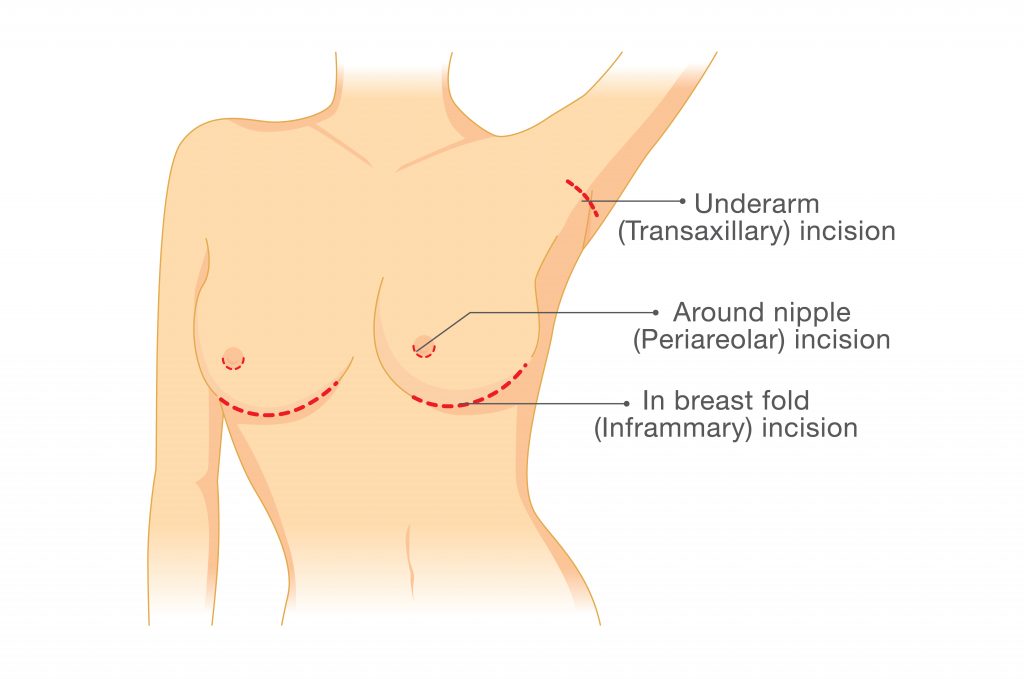Breast augmentation — also known as augmentation mammoplasty — is surgery to increase breast size. It involves placing breast implants under breast tissue or chest muscles.For some women, breast augmentation is a way to feel more confident.
What breast augmentation surgery can do?
- Increase fullness and projection of your breasts
- Improve balance of breast and hip contours
- Enhance your self-image and self-confidence
- Breast implants may also be used for breast reconstruction after mastectomy or injury.
How you prepare :
You’ll consult with a plastic surgeon about your preferences for size, feel and appearance of your breasts. The surgeon will describe specific types of implants -smooth or textured, round or shaped like a teardrop, saline or silicone – as well as options for surgical techniques.
Before you decide to have surgery, consider the following:
- Breast implants won’t prevent your breasts from sagging. To correct sagging breasts, you might need a breast lift in addition to breast augmentation.
- Breast implants aren’t guaranteed to last a lifetime. The average life span of an implant is 10 years. Implant rupture is a possibility. Also, your breasts will continue to age, and factors such as weight gain or weight loss might change the way your breasts look. These issues will likely lead to more surgery.
- Mammograms might be more complicated. If you have breast implants, in addition to routine mammograms, you’ll require additional, specialized views.
-
Breast implants might hamper breast-feeding. Some women are able to successfully breast-feed after breast augmentation. For others, however, breast-feeding is a challenge.
Procedure:
Breast augmentation can be done in a surgical centre or hospital outpatient facility. You’ll probably go home the same day. The procedure rarely requires a hospital stay.Sometimes, breast augmentation is done during local anaesthesia you’re awake and your breast area is numbed. Often, though, breast augmentation is done during general anaesthesia, in which you’re asleep for the surgery.

During the procedure,To insert the breast implant, your surgeon will make a single cut (incision) in one of three places:
In the crease under your breast (inframammary)
Under your arm (axillary)
Around your nipple (periareolar)
After making an incision, the surgeon will separate your breast tissue from the muscles and connective tissue of your chest. This creates a pocket either behind or in front of the outermost muscle of the chest wall (pectoral muscle). The surgeon will insert the implant into this pocket and center it behind your nipple.
Saline implants are inserted empty and then filled with sterile salt water once they’re in place.
Silicone implants are pre-filled with silicone gel.
When the implant is in place, the surgeon will close the incision — typically with stitches (sutures) — and bandage it with skin adhesive and surgical tape.
After the procedure:
Soreness and swelling are likely for a few weeks after surgery. Bruising is possible, too. Expect scars to fade over time but not disappear completely.While you’re healing, it might help to wear a compression bandage or sports bra for extra support and positioning of the breast implants. Your surgeon might prescribe pain medication as well.
Follow your surgeon’s instructions about returning to regular activities. If you don’t have a physically demanding job, you might be able to return to work within a few weeks. Avoid strenuous activities — anything that could raise your pulse or blood pressure — for at least two weeks. While you’re healing, remember that your breasts will be sensitive to physical contact or jarring movements.If your surgeon used sutures that don’t absorb on their own or placed drainage tubes near your breasts, you’ll need a follow-up appointment for removal.
If you notice warmth and redness in your breast or you run a fever, you might have an infection. Contact your surgeon as soon as possible. Also contact your surgeon if you have shortness of breath or chest pain
Risks and Results Includes:
- Scar tissue that distorts the shape of the breast implant (capsular contracture)
- Breast pain
- Infection
- Changes in nipple and breast sensation
- Implant leakage or rupture
- Breast augmentation can change the size and shape of your breasts. The surgery might improve your body image and self-esteem. But keep your expectations realistic, and don’t expect perfection.
- Also, your breasts will continue to age after augmentation. Weight gain or weight loss might change the way your breasts look, too. If you become dissatisfied with the appearance of your breasts, you might need more surgery to correct these issues.



